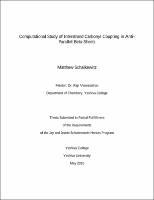Please use this identifier to cite or link to this item:
https://hdl.handle.net/20.500.12202/4161Full metadata record
| DC Field | Value | Language |
|---|---|---|
| dc.contributor.author | Schaikewitz, Matthew | |
| dc.date.accessioned | 2018-11-08T20:21:32Z | |
| dc.date.available | 2018-11-08T20:21:32Z | |
| dc.date.issued | 2010-05 | |
| dc.identifier.uri | https://hdl.handle.net/20.500.12202/4161 | |
| dc.identifier.uri | https://ezproxy.yu.edu/login?url=https://repository.yu.edu/handle/20.500.12202/4161 | |
| dc.description | The file is restricted for YU community access only. | |
| dc.description.abstract | Proteins are composed of chains of interlinking peptides, and the backbone of each peptide consists of a carbon-oxygen double-bond (C=O), or a carbonyl group. When a protein is excited by infrared radiation at the appropriate frequency, the backbone carbonyl groups couple with one another as they vibrate and the amide I band is formed in the infrared spectrum. Hydrogen bonding, covalent bonding, and transition dipole coupling (TDC) collectively influence peptide coupling and consequently affect the shape and location of this band in the spectrum. Several methods to computationally model the vibrational patterns of proteins have been developed. Ab initio calculations utilize Schrodinger’s equation and take into account all of the electronic interactions within the protein. A simpler model only considers TDC by calculating the force field interactions between the dipole moments of the backbone carbonyls within the protein. TDC calculations have become popular amongst experimental and computational chemists because they can be performed on a small timescale and they have significantly reduced the computational power necessary to model large proteins. Nevertheless, many have argued that TDC calculations cannot fully capture the coupling effects between peptide groups and must be supplemented with information obtained through ab initio calculations in order to yield accurate results. In the current study, we confirm that TDC calculations cannot accurately predict the amide I mode frequencies of model peptides in the anti-parallel beta-sheet conformation, and we claim that the primary cause of this discrepancy is the inability of TDC to capture interstrand hydrogen bonding effects. We have quantitatively illustrated this discrepancy by comparing the ab initio and TDC frequency calculations of dipeptide dimers. To see if this discrepancy is side Schaikewitz 4 chain specific, we have performed these experiments on dimers with two different side chains. Our ultimate goal is to increase the accuracy of the TDC method by constructing a new model which incorporates the effects of interstrand hydrogen bonding. | en_US |
| dc.description.sponsorship | Jay and Jeanie Schottenstein Honors Program | en_US |
| dc.language.iso | en_US | en_US |
| dc.publisher | Yeshiva College | en_US |
| dc.rights | Attribution-NonCommercial-NoDerivs 3.0 United States | * |
| dc.rights.uri | http://creativecommons.org/licenses/by-nc-nd/3.0/us/ | * |
| dc.subject | Quantum chemistry. | en_US |
| dc.subject | Molecular structure --Computer simulation. | en_US |
| dc.subject | Hydrogen bonding --Computer simulation. | en_US |
| dc.subject | Carbonyl compounds --Computer simulation. | en_US |
| dc.subject | Protein binding --Computer simulation. | en_US |
| dc.title | Computational Study of Interstrand Carbonyl Coupling in AntiParallel Beta-Sheets | en_US |
| dc.type | Thesis | en_US |
| Appears in Collections: | Jay and Jeanie Schottenstein Honors Student Theses | |
Files in This Item:
| File | Description | Size | Format | |
|---|---|---|---|---|
| Matthew-Schaikewitz.pdf Restricted Access | 1.54 MB | Adobe PDF |  View/Open |
This item is licensed under a Creative Commons License

